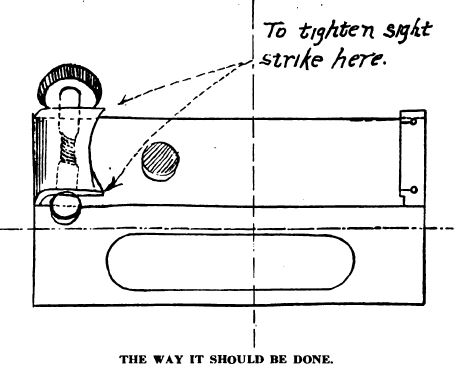
[ed. the
first article is missing from the scan! I believe this is the
1903(?) Buffington-style rear sight]
A Springfield Sight Kink
By R.E. Herrick
American Rifleman, vol 60, No. 9, May 25 1916, page 172
Pages missing from scan!
His Springfield Did Not Respond.
Mr. J. A. Botkoll
American Rifleman, vol 60, No. 11, June 8, 1916, page 212
In your last week's issue of ARMS AND THE MAN, May 25, there appeared on page 172 an article on “A Springfield Rifle Sight Kink." I tried it on my new Springfield and have about ruined the sight. The windage screw now has about two turns of lost motion and the sight can be moved sideways three or tour points independent of the windage screw. I followed Mr. Herrick’s directions very closely at that. I am in a quandary, sorely disappointed and ask you what I can do to remedy the misfortune.
Moral : Let the Springfield alone.
The Kink Straightened Out
By R. E. Herrick
American Rifleman, vol 60, No. 14, June 29, 1916, page 267
NOTE in your issue of June 8th a comment by Mr. J. A. Botkoll relative to my article published in the issue of May 25th entitled “A Springfield Rifle Sight Kink."
I am very sorry Mr. B. injured his sight, but am certain he must have deviated from my directions, and herein lies my inherent failing —laziness. I knew I should have sent a sketch along with that article, but was just too confounded lazy to make one; that, coupled with the fact that my drawings are comprehensive only when coupled with the name of that old and venerable Irish city of “Cork," played the mischief. However, here is the sketch.

Regarding the moving of the sight several points independent of the windage screw, would state that all Springfield sights can be moved to the right several points by applying pressure on the left rear side of movable sight base, and without turning the screw. This merely takes the slack out of the coil spring located under the windage screw collar.
To repeat: Must take out rear sight Then tap very lightly points indicated by arrows, and the only possible result will be the lessening of the distance between points indicated and top surface of fixed base, which will, as natural consequence, tighten worn and loosened movable sight base.
THAT “SPRINGFIELD SIGHT KINK” AGAIN
Editorial Staff [no author apparent]
American Rifleman, vol 61, No. 11 Dec 7, 1916, page 209
SINCE the publication of an article in ARMS AND THE MAN by R. E. Herrick, who gave his solution to the problem of how to tighten the rear sight on a Springfield so that the lost motion between the fixed base and the movable base would disappear, a good many riflemen have turned their attention to this question.
Mr. Herrick pointed out that the lost motion should be overcome or shots at 600 yards and up might be effected. His remedy was to slightly bend over the ends of the hoodlike hook which extends from the fixed base partly over the rear end of the sight base. This method was attacked by other riflemen who declared that the risk of ruining the sight was too great.
Comes C. W. Linder, of the Olympic Pistol and Rifle Club, of San Francisco, who offers a means of overcoming the lost motion without recourse to “battering up the sight."
Linder calls attention to a shallow slot or groove which is cut into the under side of the movable sight base, and which can be exposed by turning the windage screw to its fullest extent.
Into this groove Linder has conceived the idea of placing a spring, which, he says, will tighten up, and hold tight, the most unruly sight. The spring he makes from a good grade of corset steel, cutting it just long enough to fit the groove, with an upward bow of sufficient strength to hold the movable base rigid. A spring of this sort, inserted in the groove, Linder says, experience has showed him to be an effective remedy for the lost motion which pesters so many riflemen.